#Cynocephalus Baboon
Explore tagged Tumblr posts
Text
Aani
The dog-headed ape revered by the Egyptian god Thoth is known as Aani in ancient Egyptian religion. "One of the Egyptian names of the Cynocephalus Baboon, which was sacred to the god Thoth."
0 notes
Text

Crawshay's zebra Equus quagga crawshayi
With yellow baboon Papio cynocephalus
Observed by simontonge, public domain
#Equus quagga crawshayi#Crawshay's zebra#Equidae#horse#non-ungulate#primate#Papio cynocephalus#yellow baboon#Africa#Malawi
8 notes
·
View notes
Text
Whenever two males meet each other, they exchange a series of ritualized sexual behaviors that may include homosexual mounting and invitations to mount, as well as a wide variety of other sexual and affectionate contacts.

"Biological Exuberance: Animal Homosexuality and Natural Diversity" - Bruce Bagemihl
#book quotes#biological exuberance#bruce bagemihl#nonfiction#savanna baboon#papio cynocephalus#greeting#ritualized behavior
0 notes
Text
In South African populations, gender-mixing individuals sometimes become high-ranking and powerful members of their troops.
"Biological Exuberance: Animal Homosexuality and Natural Diversity" - Bruce Bagemihl
#book quote#biological exuberance#bruce bagemihl#nonfiction#south africa#savanna baboon#papio cynocephalus#intersex#high ranking
0 notes
Text
Several different kinds of intersexual or hermaphrodite individuals occur spontaneously in Savanna Baboons.
"Biological Exuberance: Animal Homosexuality and Natural Diversity" - Bruce Bagemihl
#book quote#biological exuberance#bruce bagemihl#nonfiction#intersex#hermaphrodite#savanna baboon#papio cynocephalus
1 note
·
View note
Text
Werewolf Fact #75 - Cynocephali (dog-headed men)
This month's folklore fact is a long-awaited one from over on the Patreon: the cynocephali or "dog-headed men."
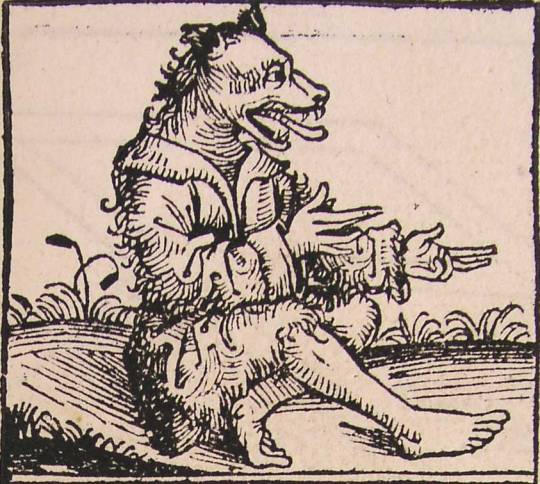
Some depictions of cynocephali (the one above is from the Nuremberg Chronicle, 1493) are mistaken for werewolves fairly frequently; there are several differences of note, including but not limited to the fact that they are otherwise very, very human (normal hands and feet, no tail, etc) and that their ears are not always shaped like a wolf's/pointing directly upright. They often are, however, so don't take the ear shape as a surefire thing, either. When in doubt, make sure the depiction is actually meant to be showing a werewolf before using it for, I don't know, a royalty-free image in your werewolf publication (I've seen several). The cynocephali do not shapeshift, nor are they associated with wolves. They have nothing to do with werewolves. Yes, it was just a plot to make you click this link and read about cynocephali.
Cynocephali, or singular cynocephalus, is a term derived from the original Greek word "kynokephaloi," meaning "dog-headed." They have other names as well, which mean a range of things such as "dog-faced" and "half-dog." They were mentioned in assorted accounts and tales of travelers in Africa and India, appearing in sources as old as ancient Greece, and some similar beings can be found in other cultures, such as China. Likewise, depictions of and discussions of such beings continue into the Middle Ages. This same term was later used to refer to baboons, to which no-fun modern day scholars now attribute all cynocephali legends (although we do have at least one Ottoman depiction of a cynocephalus battling a monkey).
There are many quotes across various sources and time periods about these beings, including but not limited to this one from the fifth century BC Greek historian Herodotus, Histories 4. 191. 3 (trans. Godley) [source: Theoi]
"For the eastern region of Libya, which the Nomads inhabit, is low-lying and sandy as far as the Triton river; but the land west of this, where the farmers live, is exceedingly mountainous and wooded and full of wild beasts. In that country are the huge snakes and the lions, and the elephants and bears and asps, the horned asses, the Kunokephaloi (Cynocephali) (Dog-Headed) and the Headless Men that have their eyes in their chests, as the Libyans say, and the wild men and women, besides many other creatures not fabulous."
Some stories of the cynocephali are also frightfully specific as to how they live, rear livestock, grow fruit, weave baskets, wage war, and much more, even including details of their society, clothing, how long they live, etc. It's all quite interesting. If you'd like to read more specific quotations, you can find many on one of my favorite websites, Theoi.
Sources seem to dispute one another as to whether they bark, do not bark but only howl, only shriek, or whatever other sounds they may make, and there is also a range of descriptions including elements such as if they have beards and whether hair covers their bodies as well as the dog-head. Overall, probably the majority of sources say they wear the skins of animals as opposed to having fur, but there are those that also call them hairy all over.
Please note that I will not be covering/discussing any gods from ancient Egypt in this post, because despite what some modern day scholars like to discuss, I don't consider them "cynocephali." They were wolf-headed deities, not dog-headed (or even jackal-headed), and are overall only related to cynocephali legends by proxy and by modern scholars always putting everything into blasted categories for their next thesis. There were some dog-headed deities in ancient Egypt, and Anubis, Wepwawet, Duamutef, etc, were not among them, and even then, we can't really assert that the dog-headed deities among the ancient Egyptians are actually related to other legends and records of cynocephali.
With that out of the way, let's continue...
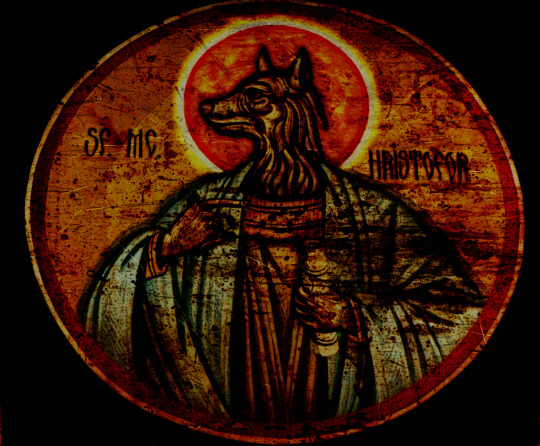
One of my personal favorite stories involving a dog-headed man is a version of the tale of Saint Christopher, though these depictions and this tale are not seen as canon by churches and has been proscribed in Eastern Orthodoxy (where such depictions were generally most common). Some of these depictions still survive, however. Some sources believe that Byzantine depictions of a dog-headed Christopher come from mistaking "Cananeus" (meaning "Canaanite") for "caninus," i.e. canine.
In the story about a dog-headed Saint Christopher, there lives Reprebrus (among other variations of his name; ultimately, they all essentially mean "reprobate"), who is captured by Romans in battle and made to serve among them. Reprebrus was said to be of "enormous size," with the head of a dog, said to be typical of his kind. He was later baptized and martyred. However, in another version (this one from Germany), Saint Christopher is depicted as a giant cynocephalus who ate human flesh and performed many atrocities. He meets the Christ child later and carries him across a river, as in tradition (the name Christopher means "bearer of Christ") and repents for his sinful behavior. He is baptized and becomes human, dedicating himself to serving Christianity and became a soldier saint.
There are far more fascinating details in the story than I relayed here in extreme simplicity, but that's a very simple view (the story is actually very specific about different regions and even the unit in which he served).
Other depictions of cynocephali exist in certain Christian traditions, with Ahrakas and Augani sometimes being depicted with dog heads in Coptic Christian tradition, in the life and legend of Saint Mercurius.
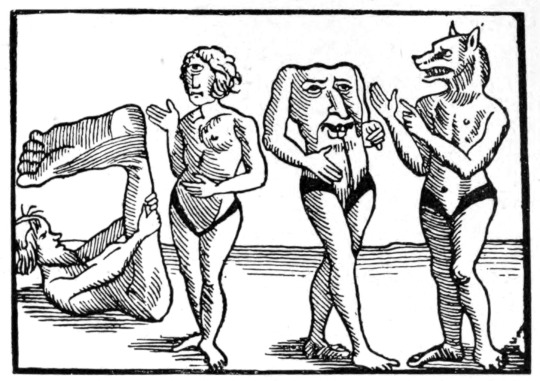
Bestiaries also got pretty wild with the creatures depicted therein, many of which were also mentioned in classical sources (such as the Herodotus quote earlier in this post). The image above is from between 1357 and 1371, in a work called The Voyage and Travels of Sir John Mandeville, or simply Mandeville's Travels, the memoirs of a man who traveled across the Middle East, India, and even as far as China. Medieval bestiaries also recorded all the same creatures shown here: a monopod or sciapod, a cyclops, a blemmy, and a cynocephalus, each different civilizations of beings said to dwell across the world (and often cited in multiple sources over considerable spans of time, which generally cite the same or similar regions for each civilization, which I've always found very interesting).
Mentions of the cynocephali span across centuries, such as in works by scribe Paul the Deacon, a Benedictine monk, and they are even mentioned in the Nowell Codex, a surviving Old English work containing Beowulf (as well as a work of the life of Saint Christopher and Wonders of the East, among others). They are also acknowledged in the works of multiple noteworthy explorers, including but not limited to Marco Polo, Christopher Columbus, Giovanni da Pian del Carpine, Ibn Battuta, and Piri Reis.
With that, I think that's a decent overview! Hope you enjoyed the post.
And stay tuned for news and updates on a major [werewolf/fantasy/adventure/horror/epic] book release later this year!
If you like my blog, be sure to follow me here and elsewhere for much more folklore and fiction, including books, especially on werewolves! You can also sign up for my free newsletter for monthly werewolf/vampire/folklore facts, a free story, book previews, and my other sundry projects and works, such as plushes.
Free Newsletter - maverickwerewolf.com (personal site + book shop + free fiction) — Patreon — Wulfgard — Werewolf Fact Masterlist — X — Vampire Fact Masterlist — Amazon Author page
#folklore#mythology#dog-headed men#dog heads#cynocephalus#cynocephali#dog man#fantasy creature#folklore fact#folklore thursday#myth#history#fantasy#werewolf#werewolves#not actually werewolves but people mix them up a lot#a werewolf has to shapeshift to be a werewolf#also these are dog-headed men not wolf-headed men#but anyway#research
76 notes
·
View notes
Text
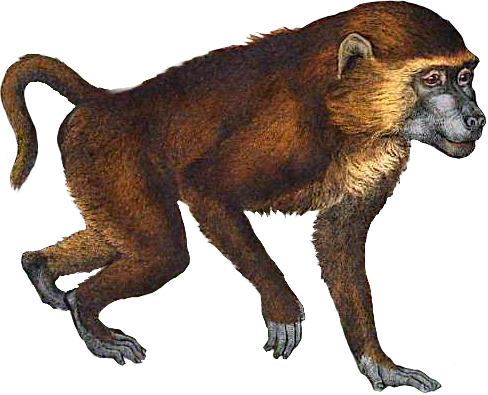

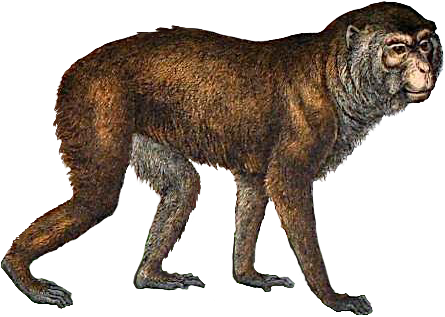
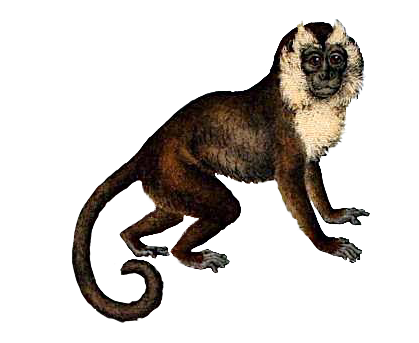
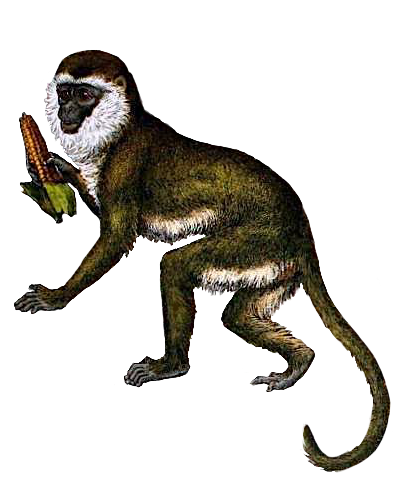

A mixture of monkeys:
Papio cynocephalus, yellow baboon Mandrillus sphinx, mandrill Macaca sylvanus, Barbary macaque Sapajus apella, brown capuchin Chlorocebus sabaeus, green monkey Alouatta palliata, mantled howler monkey
Via Natural History of the Animal Kingdom for the Use of Young People, W. F. Kirby, 1889
#mammalia#illustration#w f kirby#transparent#1889#primates#monkeys#papio#papio cynocephalus#mandrillus#mandrillus sphinx#sapajus#sapajus apella#chlorocebus#chlorocebus sabaeus#alouatta#alouatta palliata#png#vintage#antique#public domain
14 notes
·
View notes
Text
Bestiaryposting Results: Dulyamra
Odd one this week, and an entry that is... moderately identifiable? but also confusingly hostile. So let's just get into it. Anyone who's not sure what this post is can see https://maniculum.tumblr.com/bestiaryposting for an explanation and previous entries in this series.
The bestiary entry that people were working from can be found here:
And if you want to join in and draw some kind of Creature for the next one, the entry people are working from currently can be found here:
Art below the cut.
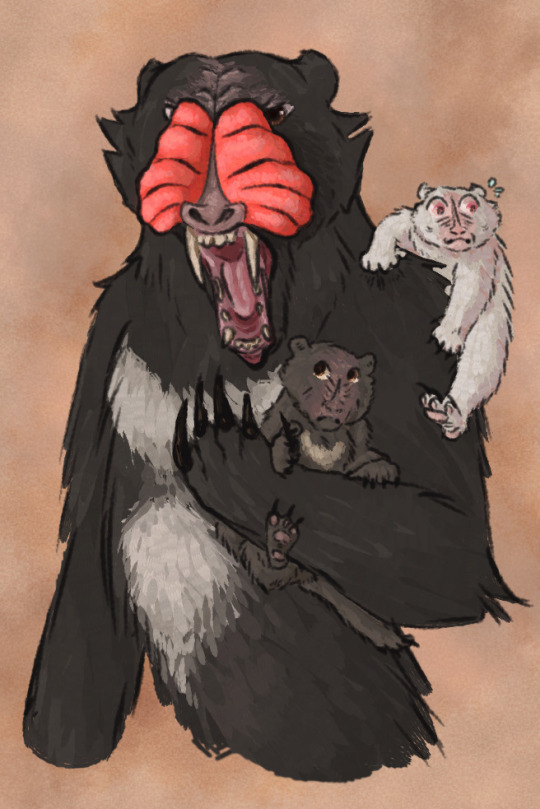
@ectocs (link to post here) was the first to post this week -- and this is their first time contributing to this! Welcome! We've got a bear-like critter here, and the weird puffy face is not unlike a mandrill, which makes sense. I think the threatening facial expression on this one is done well -- as are the clearly worried expressions on the juveniles. There's some interesting material explaining design decisions and a couple sketches in the linked post, which I recommend y'all go check out.
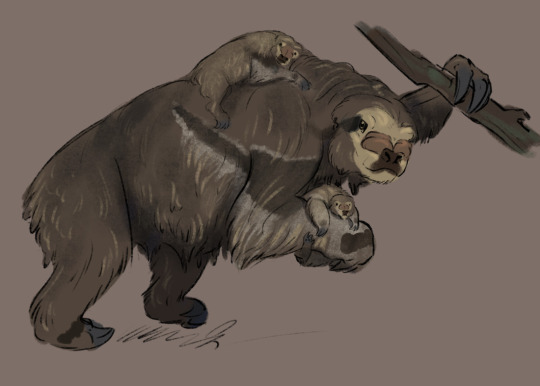
@silverhart-makes-art (link to post here) joined... most of us, actually... in being very puzzled by the bestiary's insistence that this is a Foul Beast. We get a sloth-inspired critter here, because famously sloths have a whole algae ecosystem in their fur, and some closed-minded folks may consider this foul. There's additional explanation in the linked post, including the note that Silverhart has given this creature anteater-style coloration because anteaters are related to sloths -- which I did not know previously, but now that I think about it, does make sense.

@pomrania (link to post here) decided that this creature should be a cynocephalus, but one with a red butt like a baboon to support the author's assertion that the rear is "disgusting and horrid". Honestly that makes a lot of sense with the entry, and it's always good to see cynocephali get more attention. Good direction to go. However, that butt is also unsettling for me, so I'm scrolling down to the next one now.
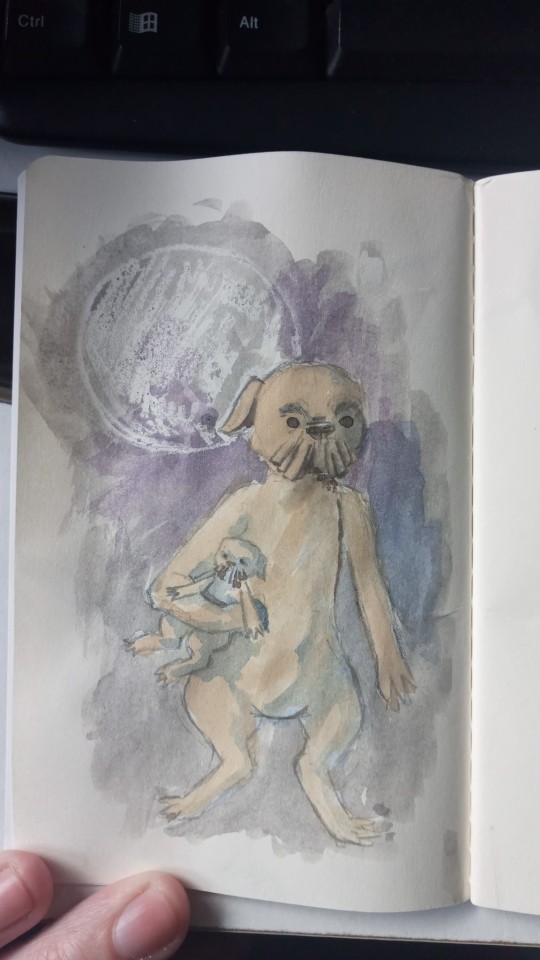
@sweetlyfez (link to post here) made the observation that a brachycephalic dog -- such as a pug -- has a creased face that many would consider hideous (or at least unethical) and ran with it. I like this interpretation a lot, and I really appreciate the coloration of the night-time scene here.
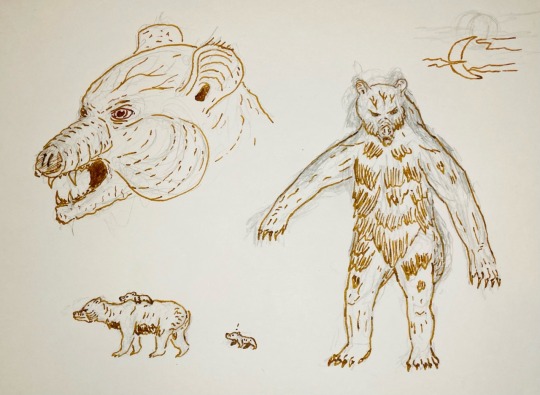
@cheapsweets (link to post here) really went hard on designing a creature that could be described as foul and hideous -- successfully, I think, because I don't think I'd want to be around this thing. The head close-up is, I think, a well-executed design for a rather frightening creature; and, of course, the overall beast here is something CheapSweets themself describes as "a semi-naked bear with a fat butt," which I think is something I'd rather keep my distance from. (Also, thank you for including alt text.)
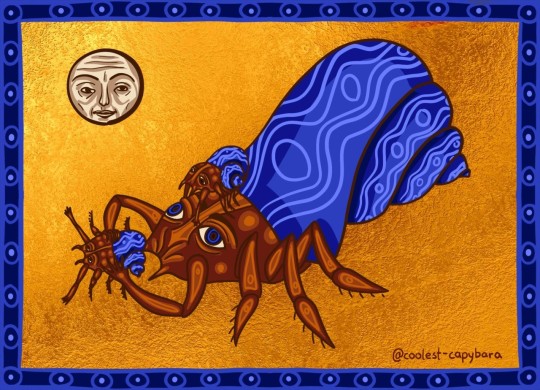
@coolest-capybara (link to post here) took this in an interesting direction. (I always enjoy it when someone decides to make one of these an invertebrate, because it usually takes some creativity to justify it.) Anyway, here we have a hermit crab, which of course has arms in the form of claws, and can conveniently hide its "disgusting and horrid" rear end in a shell. As usual, the stylization is delightful -- I like the humanoid eyes on the crab and just everything going on with the moon.
On to the Aberdeen Bestiary.
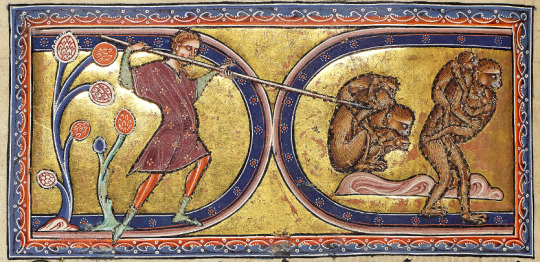
Yeah, this is pretty evidently some sort of ape. I'm not sure which one, but the bestiary author isn't either -- it just says "ape".
I don't know exactly what the medievals had against apes; in the most recent episode of the podcast, we heard a medieval fable where someone referred to them as "abominable" as though that was settled fact. I'd say it's a lack of familiarity, but also those are pretty solid illustrations of apes, so clearly they had some idea what they looked like. (One of our illustrators this week noted that they find some primates a bit uncanny-valley, so maybe that's it -- apes are just too close to human without being human, and that makes some people uncomfortable.)
Anyway, we've got some neat sequential art here. Here is a hunter with a spear. Here is an ape at rest. Here is the ape getting up and escaping from the hunter. That's cool.
I don't really have anything else to add here. Apes.
EDIT:
Thought of something to end with.

... no, that's nothing. Still leaving it there.
42 notes
·
View notes
Text

Chacma baboon - Papio cynocephalus.
Baboons are often seen among other herbivores. Being messy feeders, they leave plenty of castoff nutrient for antelope. Mingling with other animals provides an alert system against predators which benefits all grazers.
#south africa#africa#original photography on tumblr#wildlife photography#primates#wildlife#nature photography
7 notes
·
View notes
Text
I had a real shitty boyfriend that gave me lots of trauma in middle school but you know what? He did one thing good. He introduced me to the concept of Cynocephalus.

The dog-headed man of medieval legend, who was most definitely a baboon. I love him. I love the idea of a human body with an animal head. The symbolism you can do with that, the design possibilities, why this isn't a popular subset of furry cute is beyond me. Who needs paws with you can have dexterous fingers that make beautiful art and music? All the joys of humanity and all the animalistic tendencies we have portrayed physically on the body. Wolf headed politicians and terrier headed journalists. Doberman headed people who are so used to being judged they expect it and whimper when you hold their face softly, holding onto your wrists with a touch as gentle as a butterfly's.
I love them, I love them so much. I need more cynocephalus OCS.
#jack rambles#cynocephalus#medieval art#medieval beastiary#if you make cynocephalus ocs they can be friends with mine#please
5 notes
·
View notes
Text
Chacma baboons (Papio cynocephalus ursinus)
Weight: Male :27 - 50 Kgs, Female: 12 - 20 Kgs
Shoulder height: Male : 72 Cm, Female: 60 Cm
Diet: Omnivorous
Chacma Baboon is in one of four sub-species of Savanna baboon and the only one which occurs in Southern Africa.
Baboons are extremely social animals and generally form troops of between 15 - 50 individuals, with the alpha Males being dominant over females and the alpha male being the strongest amd largest male.
Troops can travel 12kms a day looking for food and water, up to 15kms per day when food is scarce , they are not territorial but do have home ranges , which sizes are dependent on food availability and sleeping places.
Gestation period is 6 months .

#safari#nature#underafricanskies#wildlifephotography#fieldguide#buyelaeafrica#thisisafrica#wildlife#facts#baboon#krugernationalparksouthafrica
1 note
·
View note
Photo

The god Thoth in the form of a baboon, Ptolemaic period, 332 - 30 BC - J.C.
1K notes
·
View notes
Text
Both sexes often make pelvic thrusts during homosexual mounts; males usually have an erection, and ejaculation does occur in at least some Savanna Baboon mounts between males.
"Biological Exuberance: Animal Homosexuality and Natural Diversity" - Bruce Bagemihl
#book quote#biological exuberance#bruce bagemihl#nonfiction#baboon#savanna baboon#papio cynocephalus#thrusting#homosexual#mounting#gay
0 notes
Text
In Savanna Baboons, the entire male population participates in homosexual "greetings" interactions; all adult males (including those in bonded coalitions with other males) are sexually active with females as well, indicating a high degree of bisexuality.
"Biological Exuberance: Animal Homosexuality and Natural Diversity" - Bruce Bagemihl
#book quote#biological exuberance#bruce bagemihl#nonfiction#savanna baboon#papio cynocephalus#homosexual#greetings#bisexual
1 note
·
View note
Photo

Yellow baboon (Papio cynocephalus)
Photo by Roman Willi
#yellow baboon#baboon#papio cynocephalus#papio#papionini#cercopithecinae#cercopithecidae#cercopithecoidea#catarrhini#simiiformes#haplorrhini#primates#primatomorpha#euarchontoglires#boreoeutheria#eutheria#mammalia#tetrapoda#vertebrata#chordata
36 notes
·
View notes
Photo

#inktober#day 15 : legend#werewolf#baboons are called cynocephalus so they are often chosen to design werewolves#also there is a theory which implies that AFRICA by TOTO is a song about a man seeking for a remedy of his werewolf condition in africa#so thats the legend of the day#an african werefolf#baboon#chimpanzee#hyena#the Unknown#chimera#446#octem 56#aqva 2#metachimera#music#halloween
73 notes
·
View notes